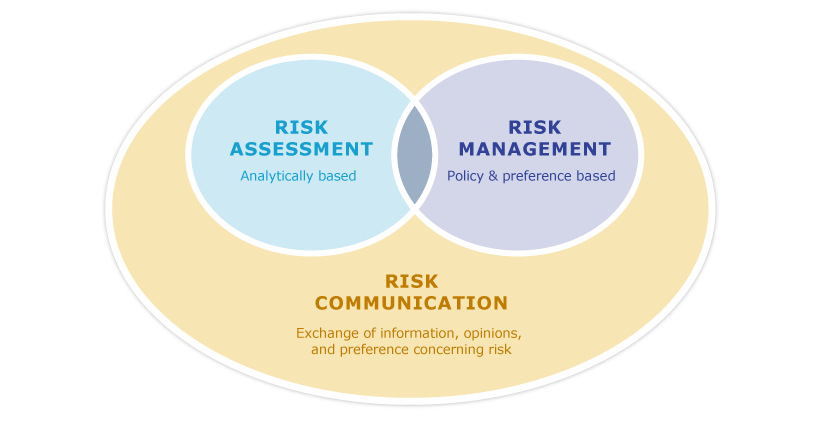Lesson 1: Review of PRA and Introduction to Risk Assessment
Topic 2: Risk Assessment and PRA
In this lesson, we will review the PRA process, focusing specifically on risk assessment. We will then discuss the basic elements of all risk assessments.
Objectives:
- Be able to define risk assessment
- Understand how risk assessment relates to the other components of PRA: risk management and risk communication
- Be able to identify the basic elements of risk assessment
Recall from Module 3.5 that risk analysis is made up of three components: risk assessment, risk management, and risk communication (see Figure 1).
Figure 1

Risk Assessment
“What is the risk?” The first step is to identify potential hazards or the things that could go wrong. Next, we characterize the risk by using the available information about our situation to determine how serious the risk will be. The magnitude of risk is based on the likelihood that each hazard we identified will happen and the potential consequences that will occur if they do.
Risk Management
After we have characterized the risk, we ask “what should we do about it?” In risk management, we identify and evaluate options that will reduce the magnitude of the risk by either reducing the likelihood the hazard will occur or reducing its consequences. In some cases, the risk may be small enough that nothing needs to be done.
Risk Communication
Explaining risk is the focus of risk communication. This should not be thought of as one-way communication that occurs only after a risk management decision is made. Instead, risk communication is essential throughout the risk analysis process, and all parties must effectively explain how they understand the risks and how they can be reduced. Risk management is not effective unless there is good communication with those who assess the risk and with anyone who might be impacted by risk management decisions.
This module focuses on risk assessment. Risk communication was discussed in Module 4, and risk management will be discussed in Module 6.
What is Risk Assessment?
In its most basic form, risk assessment is simply the process of characterizing risk. As you learned in Modules 3.5 and 4, experts generally characterize risk in terms of the likelihood that an adverse event will occur and the magnitude of the associated consequences. Therefore, let’s begin our discussion of risk assessment with a review of the four components of risk:
- Hazards. In risk assessment, hazards are anything potentially harmful to a person’s life, health, property, or the environment. In order for there to be risk, there must be potential hazards that can cause the adverse event we are concerned about.
- Likelihood. A likelihood is the probability of the adverse event occurring. What does it mean to say that risk is the likelihood of an adverse event occurring? This means that in order for risk to exist there must be some chance that the adverse event can occur. If the likelihood that a hazard will occur is zero, there is no risk.
- Consequences. The consequences are what would result from the adverse event being realized. If there were no impact associated with the adverse event, then there would be no risk, even if the probability were very high.
- Uncertainty. Uncertainty must also be present for there to be risk. Consider the situation in which an event is not just likely, it’s certain. If we know with certainty that a hazard will occur and we also know the consequences, there is no risk. Uncertainty, although not explicit in the definition of risk, is still an essential component of risk.
Keeping in mind the components of risk, it is easy to understand why the key aspects of any risk assessment include the following:
- Identifying the hazards that can cause the adverse event
- Assessing the probability (likelihood) that adverse event will occur
- Estimating the magnitude of the consequences that would likely result should the adverse event be realized
- Identifying uncertainties
- Reporting conclusions
Elements of Risk Assessment
To estimate risk, we need to think about both aspects of risk—the probability (or likelihood) that the event will occur and the consequences that will result from the adverse event being realized.
Recall from Module 3.5 that the likelihood that an adverse event will occur generally depends on a series of events, each of which has some probability or likelihood of occurring. Dependent events have a multiplicative relationship; in other words, the probability of the adverse event occurring is the product of the probabilities of each event. If any one of these events does not occur, then the adverse event will not come about. When analyzing the likelihood that an adverse event will occur, it is important to identify all of the individual events that will play a role in the overall probability that the adverse event we are concerned about will be realized.
For example, consider the series of events that must occur in order for a quarantine pest to be introduced into a new country.

The overall likelihood that the pest will be introduced into a new country is dependent on each event in the series, and the probability that each event occurs affects the overall probability that the pest will be introduced. If any one of the events has a zero likelihood of occurring—for example, if the pest is not going to remain with the commodity through harvest and packaging—the overall likelihood of introduction is zero.
As you learned in Module 3.5, consequences are the possible impacts that will result from an adverse event being realized. These can be direct impacts that occur as a direct result of the adverse event being realized, as well as indirect impacts that occur as result of the direct impacts occurring. Consequences are additive; in other words, the sum of each of the consequences equals the total impact of the adverse event. In the case of consequences of introduction, it is not always necessary to identify all of the potential consequences. Often, you only need to show that the combination of consequences will be greater than a certain amount or are more than your acceptable level of risk would allow.
Recall that risk = likelihood x consequences. The total risk, therefore, is a combination of the likelihood that an adverse event will occur times the consequences. Note that mathematically, this means that an adverse event with a low probability of occurring but a high consequence poses the same risk as an event with a high probability of occurring but a low consequence. In practice, however, we generally care much more about the high-consequence/low-probability event. Therefore, it is important to be careful when interpreting the results of a risk assessment that reports overall risk. It is often more instructive when likelihood and consequences are reported separately.
To continue, select Topic 3 from the Topics menu above or click here.